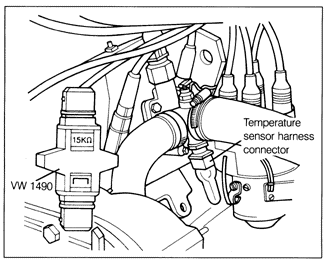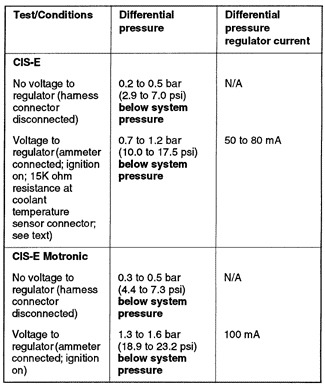Differential PressureDifferential pressure is the pressure difference between the upper and lower chambers of the fuel distributor, controlled by the differential pressure regulator. This controls the pressure differential at the fuel distributor metering ports, which determines fuel flow to the injectors and thus the air/fuel mixture. Check differential pressure with the gauge connected as described above and the gauge valve closed. Bypass the fuel pump relay to run the fuel pump, as described in 4.1 Fuses and Relays. To test, first disconnect the differential pressure regulator harness connector and read differential pressure with the gauge valve closed. The correct differential pressure values are listed in Table l. Table l. Differential Pressure Specifications

If the differential pressure is too low, measure the volume of fuel coming from the fuel distributor return line. Disconnect the fuel distributor return line from the diaphragm pressure regulator (see Fig. 6-51 above) and place the disconnected line in a measuring container suitable for catching fuel. Plug the open port on the diaphragm pressure regulator and run the fuel pump. After exactly one minute, there should be 130 to 150 cc (4.4 to 5.1 oz.) of fuel in the container. When reconnecting the line, use new sealing washers and torque the union to 10 Nm (87 in. lb.). If the fuel quantity is correct but differential pressure tested below specifications, the differential pressure regulator is faulty and should be replaced. See 6.1 Air Flow Measurement and Fuel Metering. If fuel quantity is incorrect, recheck system pressure as described above. If system pressure is within specifications but differential pressure and the measured fuel quantity are not, then the cause is most likely a faulty fuel distributor. To continue the test, connect an ammeter to measure differential pressure regulator current as described in 6.1 Air Flow Measurement and Fuel Metering. On CIS-E only (not applicable to CIS-E Motronic), disconnect the coolant temperature sensor harness connector and connect a 15K ohm resistance across the connector terminals as shown in Fig. 6-52.

Switch the ignition on and run the fuel pump. Differential pressure and differential pressure regulator current should be within the specifications listed in Table I. If differential pressure regulator current is within specifications but the differential pressure is not, the differential pressure regulator is faulty and should be replaced. If both the pressure and the regulator current are out of specifications, look for an electrical problem. See 6.4 Electrical Tests (CIS-E) or 6.5 Electrical Tests (CIS-E Motronic). Check all wires and connections. Check for a good ground connection at the cold-start valve. If no other faults can be found, the electronic control unit is probably faulty. |
